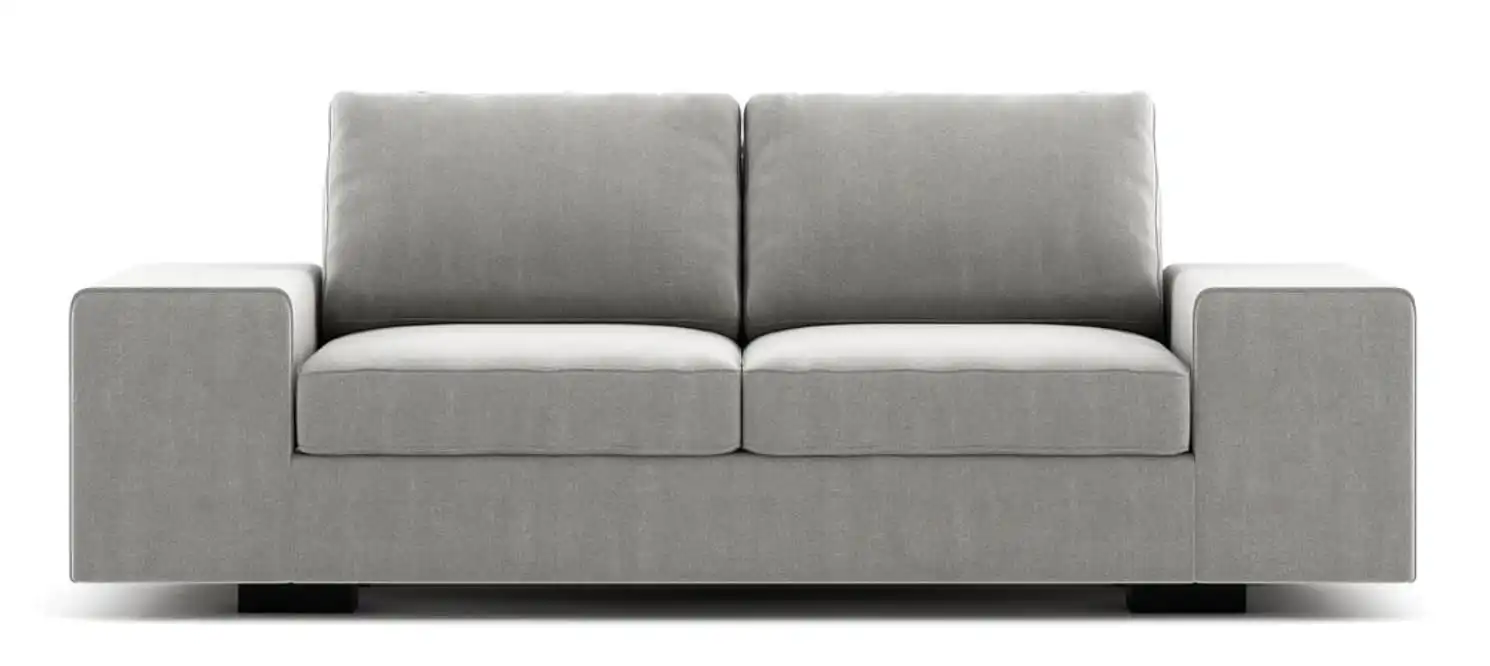- You are here:
- Home »
- Nontoxic Furniture »
- Can Sofas Be Toxic?
Can Sofas Be Toxic?
It’s a question that has been puzzling homeowners for years. The answer, it seems, is yes. Furniture manufacturers often use chemicals in their products to make them more resistant to staining and fading, but these same chemicals can release toxins into the air over time.
In some cases, these fumes can be harmful to your health. In this article, we’ll look at what makes a couch toxic and how you can avoid exposing yourself to these dangerous chemicals.
What Toxins Are Found In Sofas?
Conventional sofas and sectionals, as well as other types of upholstered furniture, may contain high amounts of potentially harmful chemicals, including:
Flame Retardant Chemicals
Most people don’t realize that their furniture is filled with harmful chemicals. Foam-filled furniture, like sofas and chairs, often contains polyurethane foam, which is infused with flame retardants. Flame-retardant chemicals are very toxic and have been linked to cancer, thyroid disruption, delayed mental and physical development, advanced puberty, lower IQ, reduced fertility, and learning problems.
Flame retardants can escape from furniture into the air, where they can be inhaled or attach to dust particles. This means that our family members, including children, can be exposed to these harmful chemicals simply by breathing the air or touching the furniture.
Fortunately, some companies, such as Medley Home, are starting to produce furniture without flame retardants. So when you’re shopping for new furniture, be sure to look for products that are labeled “flame retardant free.” By making this simple choice, you can help protect your family from exposure to these harmful chemicals.
The Foam
While polyurethane foam is a popular material for many products, from sofas to baby mattresses, it is important to be aware of its potential dangers. Polyurethane foam is made from petroleum, and as a result, it emits VOCs (volatile organic compounds) even without the addition of flame retardant chemicals.
These VOCs can cause respiratory problems and skin irritation and have been linked to cancer. In addition, polyurethane foam is not biodegradable, meaning will remain in landfills for hundreds of years. For these reasons, it is best to avoid products made with polyurethane foam.
Many safe and sustainable alternatives are available, such as organic latex sofas, so there is no need to take the risk.
The Frame Materials
If you’re looking for a new sofa, it’s important to know the materials used in its frame construction. Many sofas are made with engineered wood, a composite material made from wood fragments or fibers. While engineered wood can be a sturdy and durable option, it can also release high levels of formaldehyde into the air.
Formaldehyde is a toxic gas that can cause respiratory problems, headaches, and nausea. It’s also been linked to cancer. When shopping for a new sofa, look for one made with solid wood instead of engineered wood. You can also ask about the type of glue used in the sofa’s construction.
Some glues, like formaldehyde-based glues, can release harmful fumes into the air. Finally, ask about the type of paint or stain used on the sofa. Some paints and stains contain harmful VOCs that can off-gas into the air and potentially cause health problems.
By being informed about the materials used to construct your sofa, you can make a healthier choice for your home.
Stain-Resistant Finish
When shopping for a new sofa, you might be drawn to fabrics that boast stain-repellent finishes. These finishes are made with chemicals called perfluorochemicals (PFCs), which can be highly toxic.
Studies have linked PFC exposure to various health issues, including thyroid disorders, different types of cancer, and behavioral and developmental issues in children. Once PFCs enter our bodies, they can stay there for a long time – meaning that the effects of exposure can build up over time.
Wrinkle-resistant finish
A wrinkle-resistant finish is a fabric treatment that helps prevent wrinkles. The finish is typically applied to cotton or cotton blend fabrics. It creates a barrier between the fabric and the environment, which helps to resist creasing and wrinkling.
Wrinkle-resistant finishes are usually made from formaldehyde resin. Formaldehyde is known to cause cancer, and exposure to it can cause respiratory problems, contact dermatitis, or asthma.
People can be exposed to formaldehyde fumes by inhaling them from a wrinkle-resistant fabric or coming into contact with the fabric if the finish contains formaldehyde residue. Consequently, before using wrinkle-resistant finishes, it is important to be aware of the potential risks.
Other Toxic Chemicals in Upholstery Fabrics
Sofa upholstery fabrics often undergo harsh chemical treatment during production to meet fire safety standards. These chemicals are toxic and can leave residues on the fabrics. As a result, they will be in direct contact with our skin.
Polyester is a petroleum-derived fabric made with highly toxic chemicals, including carcinogens and endocrine disruptors. They can be absorbed by the skin or inhaled and have been linked to various health problems, including cancer, reproductive issues, and respiratory problems.
When choosing upholstery fabrics for your sofa, look for natural fibers that have not been treated with harmful chemicals.
Leather Upholstery
Many people love the look and feel of leather, but they may not be aware of the environmental and animal welfare problems associated with this material. Leather is made from animal skins treated with a mixture of chemicals to preserve them.
The most common type of leather is chromium-tanned, which involves exposing the skins to chromium salts. This process can be extremely harmful to both workers and the environment, as it can release hazardous chemicals into the air. Chromium-tanned exposure can cause different health problems, including cancer.
In addition, chrome-tanned leather is not biodegradable and non-recyclable, meaning that it will remain in landfills for centuries once disposed of.
Animal welfare groups have also raised concerns about how leather is produced. Cattle, pigs, sheep and goats are all commonly used to make leather, and these animals are often raised in cramped, overcrowded conditions. They may also be subjected to painful procedures such as castration and branding.
Therefore, it is best to avoid leather products if you are concerned about animal welfare or the environment. Many alternative materials on the market are just as stylish and much more sustainable.
Is there such thing as a non-toxic couch?
Yes, there are non-toxic couches! Some furniture companies make non toxic sofas with organic cotton, wool, and latex, with solid wood construction. These materials are often certified by one or more of the following organizations: Global Organic Latex Standard (GOLS), Global Organic Textile Standard (GOTS), and/or Greenguard GOLD.
Although some conventional sofa brands also use these materials, checking for certification before buying is important. This ensures that you’re getting a product that has been independently verified to meet strict environmental and health standards.
What to consider when shopping for a non-toxic sofa?
When shopping for a non-toxic sofa, it is important to consider the materials that it is made from:
- Look for sofas that are made with certified organic fabrics, such as GOTS certified organic cotton or Oeko-Tex certified wool. These certifications guarantee that the fabric was produced without harmful chemicals or pesticides. Additionally, organic fabrics are often softer and more durable than conventional fabrics. As a result, they provide a healthier environment for your family and can save you money in the long run. So when you’re furniture shopping, be sure to ask about the fabrics used and look for sofas made with certified organic materials.
- You want to ensure that the frame is made of solid wood, as this will be more durable and won’t contain any toxic glues. The wood should be FSC certified, to make sure it´s been responsibly sourced and won´t contribute to deforestation. Kiln-dried wood is the best option, as it has been dried slowly to prevent warping.
- Additionally, look for a sofa finished with natural oil or a zero-VOC wood stain. These non-toxic finishes will be safer for your family and won’t off-gas over time.
- Look for sofas that are filled with either GOLS certified natural latex, Oeko-Tex certified down, natural wool, or CertiPur certified foam. These certificates mean that the materials used in the sofa have been tested and certified to be non-toxic and free of harmful chemicals.
By considering these factors, you can be sure to find a non-toxic sofa with cushions filled with natural materials and upholstered in organic fabrics, that will be safe for your family and home.

How do you get toxins out of a couch?
If your couch is new, there are likely toxins in the fabric or stuffing. These can be released into the air, and you may be exposed to them if you do not take precautions. To remove toxins from your couch, you can:
- Open the windows to keep the room well ventilated. This will help to dissipate any toxins that are present in the air.
- Use a damp cloth to remove chemical residue from the couch. It will also help to remove any toxins that are present on the surface of the couch.
- Vacuum your sofa regularly and thoroughly to remove any toxic particles that may be present in the fabric or stuffing.
If you are concerned about exposure to toxins, you can also choose to purchase a sofa that is made from non-toxic materials. There are many options available, and you can find a safe and comfortable couch for your home.
FAQs
What toxic chemicals are the most common in sofas?
There are a variety of harmful toxins that can be found in couches, including:
- Flame retardants: These chemicals are often added to sofas to meet fire safety regulations. However, they can be released into the air over time, and you may be exposed to them if you do not take precautions.
- Formaldehyde: This chemical is often used in the production of sofas and can be released into the air over time. Formaldehyde exposure can cause a variety of health problems, including cancer.
- Volatile organic compounds (VOCs): These chemicals are released into the air from the sofa fabric, stuffing, and other materials. VOCs can cause various health problems, such as headaches, dizziness, and respiratory problems.
Can I test my sofa for toxins?
There are a variety of ways to test your couch for toxins. You can:
- Purchase a commercial indoor air quality test kit. These kits are available online and at some hardware stores.
- Send a sample of the fabric or stuffing to a laboratory for testing. This option is typically more expensive than purchasing a test kit.
- Contact your sofa manufacturer and ask if they can provide information about the toxins in their products.
What should I do if my couch tests positive for toxins?
If your couch tests positive for toxins, you can:
- Open the windows to keep the room well ventilated. This will help to dissipate any toxins that are present in the air.
- Avoid the couch from coming into direct contact with your skin. Use a blanket or towel to protect yourself from exposure.
- If possible, replace your sofa with one that is made from non-toxic materials.
- Remove the toxic sofa or sectional from your home and dispose of it properly.
- Contact the manufacturer and ask for a refund or replacement.
- Seek medical attention if you have been exposed to high levels of toxins and are experiencing health problems.
What are some of the most common health problems associated with toxins in couches?
Exposure to toxins can cause a variety of health problems, including:
- Cancer
- Respiratory problems
- Headaches
- Dizziness
- Nausea
- Skin irritation
If you are concerned about your exposure to toxins, you should seek medical attention. Your doctor can provide information about the risks associated with toxin exposure and offer advice on how to protect yourself.
Conclusion
A sofa can be toxic if it contains harmful chemicals that can be released into the air or if it is made of materials that off-gas. They can also adhere to dust particles and other irritants, which can cause respiratory problems.
These chemicals can cause many health problems, including respiratory issues, skin irritation, and headaches. When shopping for a couch, look for one made with natural materials and avoid those that contain flame retardants or other harmful chemicals. Be sure to ventilate your home well if you have a toxic sofa to minimize exposure to the chemicals it may release into the air.
If you think your sofa might be causing your health problems, consider replacing it with a safer option. There are many non-toxic sofas on the market made with natural materials like wool, cotton, and natural latex. They´re free from toxic flame retardants, formaldehyde and other toxic chemicals.
These sofas are not only safer for your health, but they are also more sustainable and environmentally friendly. So, if you’re looking for a new sofa, consider one of these non-toxic options, such as Medley Home Sofas.
Do you think your sofa might be toxic? Share your thoughts in the comments below!
About the Author Kamila Flieger
My name is Kamila, and I'm passionate about researching non-toxic, organic products for the home. I believe it's so important to create a safe and healthy environment for our families, and I enjoy helping others do the same.



